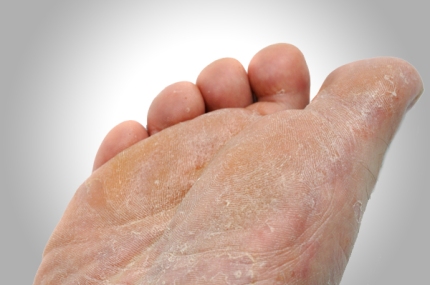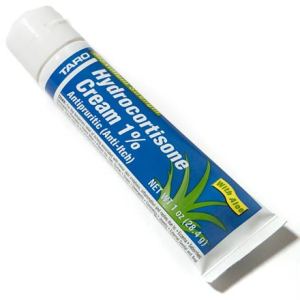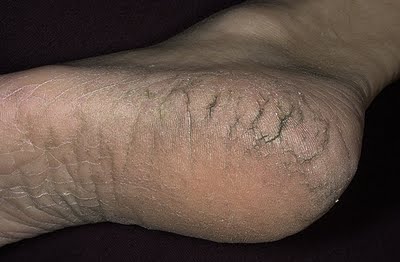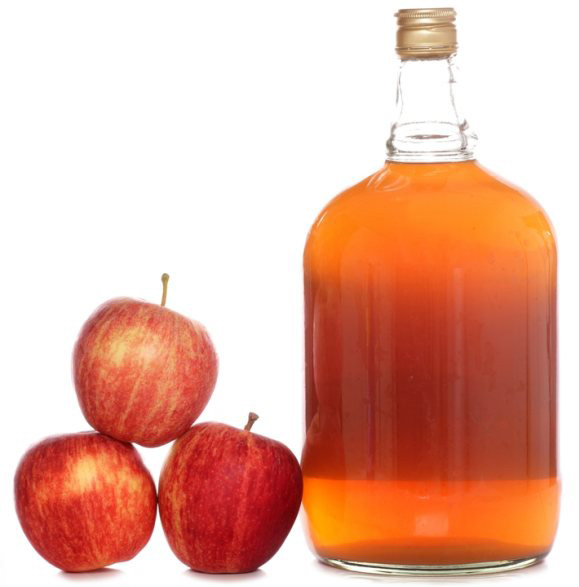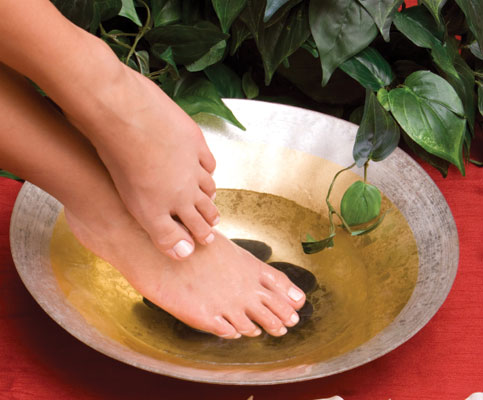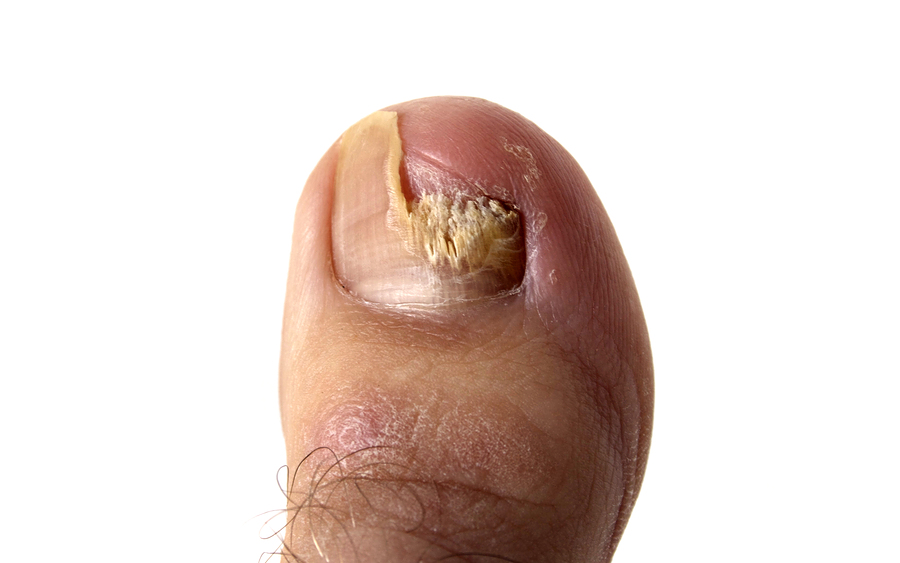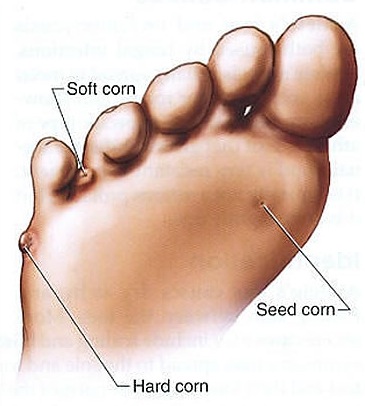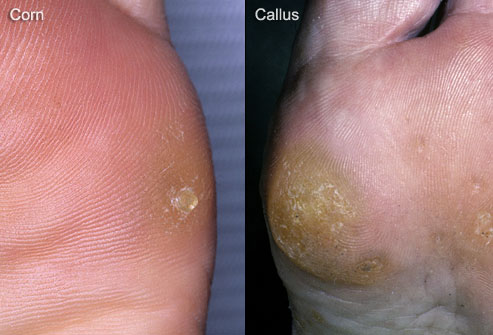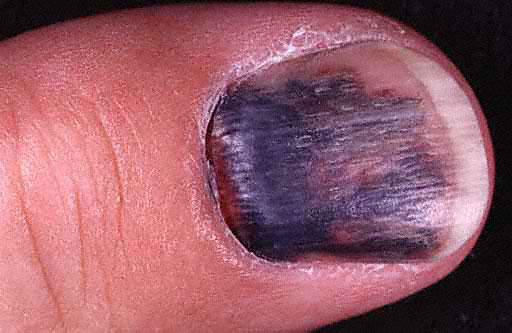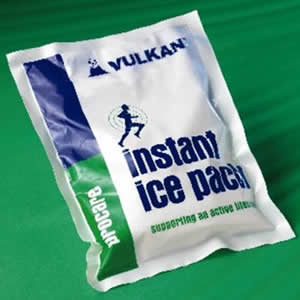Advice from a Toenail Fungus Podiatrist: Yellow and thick toenails
are usually note even caused by the fungus, but by the skin under the
nail bed!

Kill your toenail fungus infection
Causes of a severe toenail fungus infection?
Yellow and thick toenails are not
always caused by a problem with the cells that are responsible for
growing the nail. Yellow and thick nails are actually caused by what is happening in the nail bed!
Dr. Bradley Bakotic , THE leading
foot dermatology-pathologist (backed by cutting edge publications),
states that the toenail itself is rarely even thickened. He states that
it is the skin under the toenail becomes thick and spongy; it then
causes the nail to lift and the callus makes the toenail appear yellow. The thick skin under the toenail is really what is making the nail look yellow and deformed!
Over time the nails lose their blood flow from the skin underneath
them and become dry, brittle and detach from the skin underneath it. The
nails lose their pink appearance because the blood vessels underneath
the nail plate are no longer visible. This also means that the immune
cells don’t have access to the area under the nail because they are
blocked off by the spongy and thick tissue.
This leaves the area ripe for fungal invasion.

A less pink nail bed makes the nail yellow, not the fungus!
Only now does fungus get under the toenail
Once this process begins to happen, it creates a space for fungus to
enter underneath the nail. This is why nail fungus is so hard to cure!
Toenail fungus is not really the cause of ugly nails, but an inevitable
progression from the
callus formation under the nail states Dr. Bakotic and recent literature. The fungus is not what is causing your nail to look bad.
Your
nail looking bad is what is allowing the fungus to get underneath it!
My mind was absolutely blown the first time I heard this!
Ask yourself these questions before kill or remove the fungus:
It is a good idea to skim over these commonly encountered problems.
Otherwise you could spend months and huge $$$ attempting to treat the
wrong problem!
**No need to read this if you read the stuff above, but make sure to understand that the fungus is not the only thing to fix!**
Read this before attempting any home cure!
You must understand that the fungus is not what is causing your toenail fungus.
If you attempt to treat only the fungus your nails will never look better!
There is something predisposing you to being able to catch the nail
fungus. Read point #2 to find out why you are susceptible and if it is
even worth pursuing a cure.
2)Who is most susceptible to toenail fungus
First there must be some type of trauma causing
Systemic Factors
- Old Age.
- Immunosuppression.
- Poor peripheral circulation.
- Nail psoriasis.
- Onychomycosis susceptibility genetics (very rare).
Agent Factors
- Exotic non-responsive organisms (<10%)
- This is very unlikely
Environmental Factors
- Occupational factors- excessive sweat
- Occlusive footwear
- Prolonged contact with water or sugary food
Toenail fungus is not contagious unless you are susceptible to it.
There is fungus everywhere, but not everyone gets it. It is only usually
systemically compromised people. The people listed in #2 are more
contagious and susceptible for toenail fungus because of their systemic
problems. You also need to be experiencing some microtrauma and
irritation; this allows the fungus a route to get under the nail.
It is very common to remove your nail polish and see white chalky nails.
But don’t panic, it is probably not nail fungus! This is a condition known as
keratin granulations
almost all of the time; unless you are already susceptible for fungus
and the nail polish was just masking it. There is still a chance it may
be a type of nail fungus called white superficial onychomycosis; if you
are worried go see your toenail fungus podiatrist because running a lab
test is the only way to know for sure.
If you have
black toenail fungus, then this is likely not even toenail fungus. If you suspect
black toenail fungus then look at these options first:
What should you use to clear and eliminate your toenail fungus:
Should you try a Natural Home Cure? Or go straight to the podiatrist
for heavy duty treatment? If you meet the criteria for option number 1 –
you should try using home, natural or topical treatment first. There is
no guarantee that it will work, but there is no harm in trying it out.
Going
to a good toenail fungus podiatrist will boost your chances from about
0% in severe toenail fungus to above 90% according to published medical
studies.
1) Natural, Homeopathic Home Remedies or Topical Creams:
The home remedies and topical creams are not very effective on their
own. They normally work under 40% when the conditions are right. If the
conditions are not right, then there is virtually a 0% chance of them
working. This does not mean that they are bad, you can combine for
greater effect with strategies I will show you. There is also no harm in
trying the easy solution first and seeing what happens. So see if you
qualify for these home remedies:
Use Home Treatment or Over The Counter Medication if:
- Area of nail involvement is under 50% of the total nail surface.
- There is no ingrowing of the nails into the skin edges.
- The nail is not painful.
- The skin under and around the nail still looks normal and has not yet become thick.
- No White, yellow, orange, brown streaks in the nail exist.
2) Go see your toenail fungus podiatrist:
**
Unfortunately if your
nail is over 50% involved, it will be very difficult (but still
possible) to cure your nail fungus at home**
A toenail fungus podiatrist can provide you with many services such
as evaluating why you are predisposed to toenail fungus in the first
place. They can correct these problems and make sure you are not
susceptible for further toenail fungus. They can also place you on
systemic medications, which when combined with dremeling and topical
medications can produce an 90%+ cure rate.
You need a Podiatrist if:
- If you have trouble walking or have toe pain.
- If you have never been evaluated for why you have space under your toenail.
- If this is all very overwhelming to you.
- If all toenails are 100% involved, thick or crumbling.
- Immunosuppression (Diabetes, Rheumatoid arthritis or any systemic disease).
- Diminished peripheral circulation (Peripheral vascular disease, smoking, high blood pressure or more).
- Poor nail growth (nail has detached before, loose edges).
- If you are over 65 years of age.
- If you are a child under 18 years of age.
How to get cured: the home treatment review guide
Note #1: Be careful using any of these methods at home- this
guide is for educational use only and should never be attempted without a
toenail fungus podiatrist for supervision.
Note #2: Remember that any home
treatment or topical medication will only give you a 40% cure rate. And
that is if you qualify for home treatment. Home Treatment or Over the Counter Medications will not work if you have any of the following:
- >50% nail involvement.
- An entire hand or foot involved.
- Any systemic abnormalities that will depress your immune system: Smoking, PVD, Diabetes etc.
- Any of the criteria listed above.
Note #3: If you still want to try these- your toenail fungus
won’t get any worse. It may even be advised that these be combined with
the more advanced systemic medications. Check with your toenail fungus
podiatrist.
Before you get started, get one of the following tools:
- Emery Board.
- Nail File.
- Pumice Stone
Thinning your nails makes treatment 25%+ more effective!
Studies show that using an emery board to file your nails down in
thickness increase the effectiveness of all of the following treatments
by 15-25%. This is especially impressive when they only had a 40% chance
of working in the first place!
A thick layer of fungal biofilm needs to be removed to allow treatment penetration.
The toenail fungus can create a thick impenetrable layer of biofilm
that prevents treatment agents from entering into the nail bed. This
lack of penetration under the nail plate is the #1 cause of treatment
failure!
Research states that as you thin down your nails with an emery board
or a pumice stone as described in treatment, you gain a 15-25% increased
chance of the following treatments in working for you.
So trim and thin your nails before the following treatments are tried!
- A Spanish study states that Vick’s Vapor rub is very effective.
- The Mayo Clinic states that while many people vouch for this
treatment method, it is difficult to prove that the Vick’s Vapor Rub is
effective.
Vick’s Vapor Rub contains ingredients which have been independently proven to have anti-fungal properties in studies.
- Camphor (4.8%).
- Thymol (1.2%).
- Menthol (2.6%).
What to do:
- For this to work, you must fix whatever is allowing you to be infected with toenail fungus in the 1st place.
- Rub it onto your nail every night before you go to bed.
- Put some socks over it so it does not get onto your sheets.
- It is essential that you do this for at least 6 weeks to 3 months to eradicate the fungus from your nails.
- The nails then need 6-9 months to grow out.
- A Michigan State University (MSU) study shows that Vinegar has anti-fungal properties.
- The MSU study has specifically to reduce nail fungus symptoms and
even cure the fungus, but it was in very superficial fungus in
completely healthy people.
- Apple Cider Vinegar provides a inhospitable acidic environment for
the fungus. It is common to hear stories about how pouring just a little
bit on foot skin fungus has made people almost instantaneously better!
What to do:
- Pour some apple vinegar or some white vinegar (either is fine) into a tub of warm water.
- The mixture can be 50/50 or 33/66 if your skin becomes irritated.
- If the skin becomes irritated, then slow the treatment down; do it every second day instead of every day.
- It is essential that you do this for at least 6 weeks to 3 months to eradicate the fungus from your nails.
- The nails then need 6-9 months to grow out.
- Put lemon or orange peels into the vinegar while you are storing it
within the fridge, this will help eliminate the vinegar smell.
There is much less research behind using Listerine for toenail
fungus. But like vick’s vapor rub, there is a good amount of
testimonials stating it works, and the ingredients are anti-fungal. Thus
there has to be something behind it.
Listerine contains the ingredients which have been independently proven to have anti-fungal properties in studies.
- Camphor.
- Thymol.
- Menthol.
What to do:
- The goal is to rub it onto your nail every night before you go to bed for six weeks.
- Pour some Listerine into a tub of warm water.
- The mixture can be 50/50 or 33/66 if your skin becomes irritated.
- If skin is irritated do it every second day instead of every day.
- It is essential that you do this for at least 6 weeks to 3 months to eradicate the fungus from your nails.
- The nails then need 6-9 months to grow out.
It is amazing how difficult it is to treat your fungal nails, but
then people jump right back into the situations that caused it in the
first place. It is essential that you start to control your sweating,
correct your footwear (and throw out the disgusting gym shoes!), use
anti-sweat powders and use lysol to spray down your old shoes.


